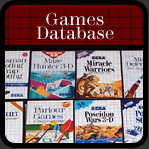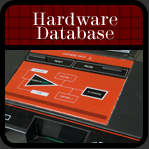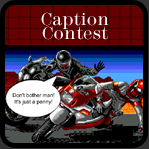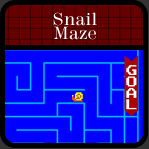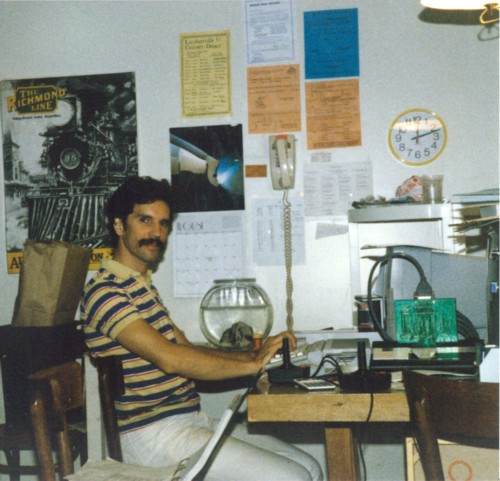 |
||
|---|---|---|
| A bit later on you'll read a bit about what that crazy looking thing is there. |
Scott Marshall didn't start out as a programmer, though his work with games would stretch over two decades. You can check out his most current resume of video game work here. He grew up in Princeton, New Jersey, spending his early education at Princeton High, and eventually graduating in 1969, moving on to college to study filmmaking at the School of Visual Arts in New York. Always having an interest in "movies, music and machines," he didn't enter into the field of video games until slightly later. For those of you who may forget since we're enveloped by them anymore, video games didn't become popular back in the 70s until Nolan Bushnell released Pong in the arcades. Scott himself, seeing the machine at a local bar in 1972, became transfixed with the idea of programming being used to create images that could be manipulated by a player. Video game history had just begun and during this time, which he says was really the main time he spent playing them before he started programming, he was pretty much stuck in arcades with games like Frogger, Battlezone and Tempest. After college, he started working in the technical side of film and television, which soon landed him a job with RCA Laboratories working on their home computer project. This was his start in computer programming, which of course eventually led to game programming, though at first he did some work on interactive video and RCA's flight simulator. An outside consultant of RCA, the famous Gary Kitchen, hired Scott to work on games for his company Imagineering after RCA disbanded. Imagineering did some work on a few Atari 2600 titles and then 7800 titles, eventually becoming a fairly well-known company. Scott's first commercial game was an adaptation of the arcade title Crossbow for the latter system, ported from the original arcade version by the legendary Exidy. The picture above is him working on the port; check out that sweet programming set up. He signed the contract for Crossbow on 1 November, 1987 and fter another title for the 7800, Touchdown Football, began work on R.C. Grand Prix, his first original game.
Under contract with Absolute and Imagineering, he was soon approached by Dan Kitchen to create an R.C. racing game to rival R.C. Pro-Am on the NES. In case you're confused, Absolute and Imagineering were essentially the same company, the first being for game publishing, the second for development, both owned by the Kitchen family. Obviously, this was done so that if one were to have gone bankrupt, the other wouldn't have tanked with it. I asked Scott if he ever spoke with the legendary David Crane, who worked for the company, but he stated that the guy always seemed too busy working on A Boy and His Blob to bother with anything, so don't bother asking about it. Anyway, under contract, he started to work. Scott himself stated that he wasn't a big fan of the SMS, and in fact he didn't even own one. "Nice colors and static graphics, but the dynamics and moving image ability of the system was a bit crippled compared to the NES, and the sound chip was inferior also. The SMS games, overall, didn't appeal to me much. The NES games had a better flow and feel."
At the time, however, as Scott commented, "Sega's Master System was considered to be far superior to the NES and numerous companies and programmers thought it would eventually overtake the competition and move to the forefront." It would have been nice, but of course this never happened, but before anyone knew this, Gary Kitchen asked Scott to create a game more realistic than R.C. Pro-Am, something to draw more attention to the Master System due to the popularity of Rare's famous title on the NES. Scott's typically "made sketches, described what the game needed, and specified the exact sizes in pixels sprites and background blocks and characters need to be," so using his skills he got to work. Coincidentally, the tester who worked for Absolute and Imagineering, Robert Prescott, was an R.C. enthusiast and was thus instrumental in the push to make R.C. Grand Prix feel like you were really driving remote controlled cars. The idea was simple, create something better than R.C. Pro-Am, and to be more specific, something more realistic.
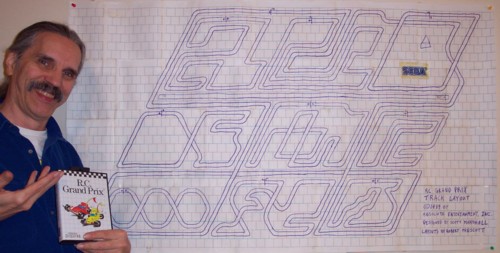 |
||
|---|---|---|
| There he is with the original track map and one of ten copies he received of R.C. Grand Prix after it was finished. |
One of the first aspects they decided on was the oblique camera angle, sketched and created by Dan Kitchen. Scott liked it because it was different from R.C. Pro-Am (where basically your car is static and the screen moves around it) as well as presenting a programming challenge. "To build the track, the whole thing was put together like 'staggered bricks' instead of the typical grid (this will be explained in detail on the next page, so bear with me for now)." To further separate it from R.C. Pro-Am, Prescott came up with the idea of improving the cars and a few track layouts and Scott came up with the idea of a "giant, interwoven track, prize money to buy improvements, the bonus drag race and making it a multi-player game." The racetrack was designed to feel more like a real R.C. course, as they would sometimes be set up in this way and some of the actual courses in Grand Prix were based on real tracks. The picture above is Scott today with the original design for the entire layout of the game before programming began. If you want a gigoonda image to check out closer and see the block pattern he created as close as you can get without owning it, click on some of this:
Anyway, features like the prize money found in the game were a nice touch, this in particular because it's something completely absent from R.C. Pro-Am. The only way to upgrade cars in that title is to collect icons along the course. Adding the store and cash worked much better, because it gave players more freedom with play and strategy. They were originally thinking of adding 'lucky charms' on the tracks to increase speed and such as found in R.C. Pro-Am but ran out of time, though Scott says they would have likely canned this idea in the first place because it would have made R.C. Grand Prix unrealistic. The store, thus, was a great addition, and as an added bonus, guess who's behind the counter? That's right, artist Jesse Kapili sketched Scott from a photo and a junior programmer, Donald Han, was responsible for putting together this bit of the game. Here, check it out:
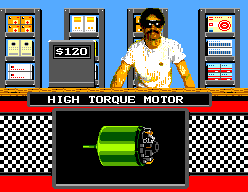 |
||
|---|---|---|
| There he was the whole time, hiding within his own game, achieving true immortality! |
Two other features include the bonus drag races which offered a nice break in the midst of the multi-player mode, another cool freature in R.C. Grand Prix that always made R.C. Pro-Am something of a snore. The latter is only single player, there was no opportunity for more than one player to participate and with a computer AI literally programmed to be unbeatable later on, the fun can wear out pretty quickly. Scott got the idea of a multi-player format and its arrangement initially from the game M.U.L.E., an old war-game type strategy title where you control interplanetary farming. In case any of you were wondering about the four-player thing in light of Nintendo's attempt at utilizing accessories that feature simultaenously four-player action, Sega had no plans on a four-player accessory like the one released for the NES, so this feature found in Grand Prix was merely an additional one to make it more enjoyable, not something that was started because of potential game play changes yet to come. Of course, no more than one-player plays at a time, but the computer was programmed to play with the upgrades the other players purchased, so it was essentially like everyone was engaged in the same game at the same time.
Another feature found in R.C. Grand Prix that was considered at first instead of outright changed or rejected was a small map displaying the location of cars on the track, but this idea had to be canned because they couldn't put an onscreen map up in R.C. Grand Prix at the same time as all four cars due to a technical limitation of the Master System. As it was, they had to flicker the cars to keep the game running when they were lined up horizontally and an onscreen map would have made it even worse. Ever wonder about that? You'll get way more detail about programming that aspect in the next section. Another way they were able to further offset the lack of a map involved a simple trick Scott came up with so the race could stay as even as possible. "If any computer car is offscreen, it will slow down and 'throw the game' if it's ahead of you. Thus, its accelerator is oscillated on/off (50/50) every 1/30 second to do this. As soon as it's visible, though, it goes back to doing its hardest to beat you, so don't bank on it playing loser to win. As a further bonus, to deal with the fact that some aspects would have to be memorized to complete the game, they added arrows and a beep that alerts you of an oncoming turn, which double as internal checkpoints to make sure you've completed the laps and haven't tried to take shortcuts or drive backwards." And in case you were wondering why you run into the sides of the course instead of skidding off, since the latter would obviously be as real as possible, the thing was that the "program fell apart if you drove off the track so stopping you when you hit the track edge was the only way I could think of to avoid certain technical problems."
 |
||
|---|---|---|
| Not that close in visual elements in these shots perhaps, but the code is there. |
After six months of work, R.C. Grand Prix was put onto the market, and ended up being quite an entertaining game and certainly much more realistic than R.C. Pro-Am. Though I honestly find some of the controls difficult to get used to at first in comparison to the other, the multi-player feature as well as the fact that R.C. Grand Prix actually has an ending more than makes up for this minor issue. Nothing was more boring that sitting around, playing Pro-Am while everyone wanted to have a go, going against a computer opponent that eventually became a genuine soldier of Satan. Scott was happy with the result overall, though he wishes the Master System had "more sprites, faster screen updates, better sound (more varied waveforms and deeper bass tones)." Still, what came out in my opinion is a good game.
When R.C. Grand Prix hit the market, it fared pretty well for the Master System overall, selling roughly 10,000 units in the US and over 100,000 in Australia alone. Scott, unfortunately, was never made aware of its release in Europe or Brazil, which he should have received royalties for. Many programmers at that time, especially those working for third-party companies, were often treated pretty poorly. As he told me, Absolute had a bad habit of not informing developers of issues like distribution so they didn't get any royalties. Scott was originally told that Absolute was going to publish R.C. Grand Prix but in a kick in the junk after he finished it, they dumped it for quick cash to Seismic. Aside from this, Scott was confused about the decision to go with Seismic, because he was originally told Absolute was handling R.C. Grand Prix. He's not sure they were doing a "bait and switch" or improvising. They started him on the project with the promise that they would publish the game, then after he finished it, said they were selling it outright to Seismic. It seems they were chosing the option with lowest risk, even though it had a lower money-making potential. Their options were: 1. Publish it themselves, throw another couple hundred thousand at it (manufacturing, advertising, etc.) and perhaps lose it all or 2. Cash in for a quick profit by selling it to another publisher willing to take the risk. For his games, he seemed to sadly state, they always chose option 2. But he certainly enjoyed every moment of it, and stated to me, "I definately get some enjoyment from taking a machine (or program) that's not doing anything, and little by little, bringing a fantasy world to life. How many people get to do that? I also enjoyed crafting the music and sound effects. When the SMS first played the full musical piece I'd written, I was so thrilled that I made a tape of it and listened to it in my car for days. Working with the artists was fun and it was a real pleasure to see what they came up with and got it up on the SMS screen for the first time. It was also a bit trippy to walk into a game or toy store and see something from your home in a store checked out by the public. To find out R.C. Grand Prix was quite popular in places like Australia and Brazil is an amazing feeling, like this little thing you've done in your home has gone out to the world and given hundreds of thousands of people enjoyment is rather cosmic."
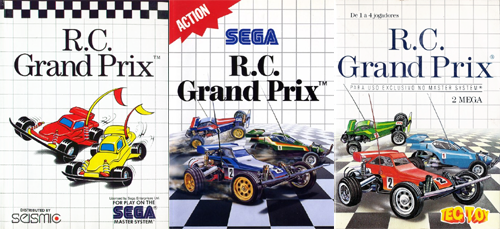 |
||
|---|---|---|
| From left to right, the US, European and Brazilian releases of the game. |
So thus released on the world, his creation went into video game history as one of the earliest R.C. games, later ported with minor changes to the Game Gear and eventually, much later, for Majesco, it was converted into "Tonka Raceway" and then "Nicktoons Racing," both for the Gameboy Color, with little more than different track layouts and graphics (see the side-by-side comparison above). Hmmm, makes you wonder how often companies take old code and programming to make what seem to be 'new' titles... Well, we'll leave the history at that mystery. As for the Master System, I asked him if he were paid for it, what type of game would he make now for the system? His answer was "Probably a puzzle-solving adventure game like Zelda and Ghoul School. That type of game hadn't been invented when the SMS was hot. I'd invent a new story line and characters for it." Considering that Ghoul School (the game I interviewed him about previously), was not put together as he wanted and was butchered by his company, perhaps it would be something to do. But for now, let's get onto the code. Ever wonder what it was like programming for the Master System? How was it done? What did it entail? What the hell does any of that code mean anyway? Time to tell you all about it...



